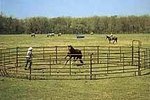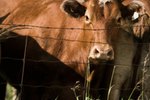Starting a hobby farm can enable you to own the livestock and plant sustainable crops to feed your family. Hobby farms differ from for-profit farms because the owners don't expect to make a profit running the farm, even if they sell produce, livestock or meat. Before you get started on your quest for the right hobby farm, determine what you want to produce. Focus on certain animals or plants, or diversify with several species.
Know Your Land
Before you purchase that cow, know what your land is capable of sustaining. If you live on a rocky crag in the mountains, you're probably not going to have much room for cattle. Likewise, if you live in a northern state, you're unlikely to plant sugar cane or coffee. Ask your neighbors what they've tried to produce and what the outcomes were.
Know Your Zoning Laws
If your hobby farm is in suburbia, chances are there are zoning limitations or homeowner's covenants for what kinds of animals you can have, or even what kinds of plants you might grow. Contact both your county zoning department and your homeowner's association, if you have one, for rules governing animals and hobby farms.
Plan Your Farm
Know where your animals are going to graze and what shelter they're going to use. Plan where you're going to grow feed for them, where the orchard and garden are, and what tools you're going to use. Plan your water management strategy. Know how you will provide water to your animals both winter and summer. If you are planting crops, know how to irrigate the fields to ensure the crops grow. If you don't have a full-time creek or pond, you'll have to have stock tanks and ways to get water to them. Plan fencing to keep your livestock from getting out and predators from getting in. Determine how much you're willing to spend on each component, and plan to build on it as the farm's production increases. Budget not only for new animals, crops and equipment but also for repairs, emergencies and veterinary bills.
Choose Your Livestock and Crops
Once you plan your farm, choose your livestock and crops. Poultry such as chickens, ducks, turkeys and geese can provide meat and eggs. Cattle, sheep, goats, pigs, llamas, alpacas and horses are good livestock, but knowing what your land will support will influence your decisions. If you're looking to raise animals for meat, consider cattle, sheep, goats and pigs. Milk producers are dairy cows, goats and, to a certain extent, sheep.
Crops are just as important. Contact your county extension office for recommendations as to what grows well in your area. They can direct you to plant varieties that thrive in your climate zone and soil.
Start with one or two crops or animals. The first few years require a steep learning curve, if you've never done this before. Ask advice from neighbors or other people who have experience with your crop or livestock. As you learn, you'll find that you may be able to branch out.
Changes
All farms evolve, and yours will most likely. Learn what you can about new animals and crops to add to your farm from farm shows and fairs. As you discover what works well in your hobby farm, you'll build on profitable centers and find ways to add to them.





